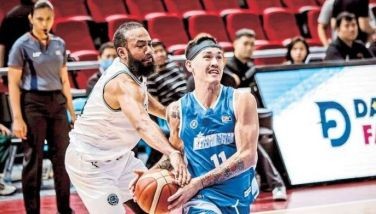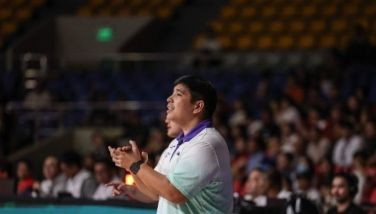Fil-Am ready to slug it out
October 20, 2000 | 12:00am
In baseball, everything can change with one swing of the bat. New York Mets outfielder Benny Agbayani proved this again when he smacked a game-winning homerun in the bottom of the 13 inning in game three of their Division Series against the San Francisco Giants. The Mets eventually wrapped up the series and made it all the way to the World Series against the New York Yankees beginning tomorrow (Sunday in Manila).
Mets fans can expect more heroics from Benny, who is part-Samoan and part-Filipino.
Benny Peter Agbayani, Jr. was born on Dec. 28, 1971 in Honolulu, Hawaii. His grandfather, Ambrosio, came from Ilocos Norte. His father is a retired government employee who is now the dance director of the Hawaii Ballroom Dance Association. His mother, Faith, works for the phone company in Aeia, where the family is now residing. He has two brothers, and he married his wife, Niela, in a ceremony at home plate in 1998.
Baseball wasn’t exactly Benny’s favorite sport. Although he starred in Little League competitions and he even slept in his baseball uniform as a kid, he initially dreamt of becoming a professional football player. Thus, after graduating from St. Louis High School in Honolulu, he went to Oregon Tech to play wide receiver on the school’s football team. He later transferred to Hawaii Pacific University and completed his college education there.
Benny’s baseball career started inauspiciously. He was selected by the California Angels in the 25th round of the 1992 Free Agent Draft but did not sign. A year later, he was drafted in the 30th round by the New York Mets, but was relegated to the minor leagues for the next five years.
His major league debut didn’t came until June 17, 1998. This gave him a chance to play alongside the legendary Rickey Henderson, whom he grew up idolizing. He was also reunited with Mets manager Bobby Valentine, who once managed him in the minor leagues and taught him his now-familiar leg kick with which he starts each swing. His initial stint with the Mets, however, didn’t go well. It only lasted four games in six days, after which he was quickly sent back to the minors. He was called up two more times, but the numbers he turned in that year were not pretty. In the 11 games he played, he only had two hits in 15 at-bats for a measly .133 average.
Fortunately, Benny got another chance in 1999, when the Mets outfield became depleted due to injuries to Henderson and Bobby Bonilla. Right on his first game after rejoining the team, he immediately made an impression by hitting his first major league homerun in a game against the Colorado Rockies. He subsequently became the fastest player in Mets franchise history to get 10 homeruns in a season, when he connected for his 10th homerun in only 73 at-bats. This made him an instant celebrity in New York and a crowd favorite at Shea Stadium, where Elton John’s "Benny and the Jets" is now played every time he steps up the plate.
Benny finished the 1999 season with 14 homeruns and a more respectable .286 average. He played a total of 101 games, had 79 hits, scored 42 runs, drove in another 42 runs, and stole 6 bases. All these, however, were not enough to secure Benny’s place in the Mets lineup. Before the start of the 2000 season, an ESPN scouting report predicted that Benny won’t probably repeat his slugging exhibition in the previous year and could easily slip back to the minors. True enough, when the Mets opened their season against the Chicago Cubs in Japan, there were already talks that Benny would be sent down when the team got back.
Benny changed all that with, yes, with just one swing of the bat. With the scored tied at 1-1 and with the game stretching to 11 innings, Benny came on as the pinch hitter with the bases loaded and hit a dramatic grand slam.
It was the start of what turned out to be a banner year for Benny. When Henderson was released by the Mets in May, Benny suddenly became an important part of the Mets outfield rotation. He started in most games at the second half of the season, and this allowed him to greatly improve on his performance last season. At the end of the regular season on October 1, he had played a total of 119 games, had 101 hits including 15 homeruns, scored 59 runs, tallied 60 RBIs, and stole 5 bases. More importantly, he raised his average to .289, which is better than Ken Griffey, Jr.’s, .271.
Benny did have some embarrassing moments as well. In a game against the Giants last August, with the bases loaded and with only one out in the fourth inning, catcher Bobby Estallella hit a deep flyball that Benny easily caught. Thinking that the inning was over, he immediately handed the ball to a young boy in the stands. The Giants had scored two runs before he realized his mistake. Fortunately, they still won the game and they had a good laugh about it afterwards. "I screwed up," he later said. "It was just a mental lapse and it shouldn’t have happened."
Knowing Benny, such lapses surely won’t happen again, especially now that the Mets have a legitimate shot to be the 2000 World Champions. Whatever happens in this post season, however, Benny has already secured his place in New York Mets’ history. His heroics should, at the very least, guarantee an extension of his contract, which is ending this season.
Whatever happens in his baseball career, one thing that Benny will never forget is his heritage. He is wearing number 50 in honor of Hawaii, which is the 50th state of the US. A lacquered coconut doll with decorative feathers and dried grass also hangs from the top of his locker in the Mets’ clubhouse. "It’s a Hawaiian warrior helmet," he pointed out. "I touch it. I stare at it. It reminds me to be a warrior out on the field. Then I go out and play."
Mets fans can expect more heroics from Benny, who is part-Samoan and part-Filipino.
Benny Peter Agbayani, Jr. was born on Dec. 28, 1971 in Honolulu, Hawaii. His grandfather, Ambrosio, came from Ilocos Norte. His father is a retired government employee who is now the dance director of the Hawaii Ballroom Dance Association. His mother, Faith, works for the phone company in Aeia, where the family is now residing. He has two brothers, and he married his wife, Niela, in a ceremony at home plate in 1998.
Baseball wasn’t exactly Benny’s favorite sport. Although he starred in Little League competitions and he even slept in his baseball uniform as a kid, he initially dreamt of becoming a professional football player. Thus, after graduating from St. Louis High School in Honolulu, he went to Oregon Tech to play wide receiver on the school’s football team. He later transferred to Hawaii Pacific University and completed his college education there.
Benny’s baseball career started inauspiciously. He was selected by the California Angels in the 25th round of the 1992 Free Agent Draft but did not sign. A year later, he was drafted in the 30th round by the New York Mets, but was relegated to the minor leagues for the next five years.
His major league debut didn’t came until June 17, 1998. This gave him a chance to play alongside the legendary Rickey Henderson, whom he grew up idolizing. He was also reunited with Mets manager Bobby Valentine, who once managed him in the minor leagues and taught him his now-familiar leg kick with which he starts each swing. His initial stint with the Mets, however, didn’t go well. It only lasted four games in six days, after which he was quickly sent back to the minors. He was called up two more times, but the numbers he turned in that year were not pretty. In the 11 games he played, he only had two hits in 15 at-bats for a measly .133 average.
Fortunately, Benny got another chance in 1999, when the Mets outfield became depleted due to injuries to Henderson and Bobby Bonilla. Right on his first game after rejoining the team, he immediately made an impression by hitting his first major league homerun in a game against the Colorado Rockies. He subsequently became the fastest player in Mets franchise history to get 10 homeruns in a season, when he connected for his 10th homerun in only 73 at-bats. This made him an instant celebrity in New York and a crowd favorite at Shea Stadium, where Elton John’s "Benny and the Jets" is now played every time he steps up the plate.
Benny finished the 1999 season with 14 homeruns and a more respectable .286 average. He played a total of 101 games, had 79 hits, scored 42 runs, drove in another 42 runs, and stole 6 bases. All these, however, were not enough to secure Benny’s place in the Mets lineup. Before the start of the 2000 season, an ESPN scouting report predicted that Benny won’t probably repeat his slugging exhibition in the previous year and could easily slip back to the minors. True enough, when the Mets opened their season against the Chicago Cubs in Japan, there were already talks that Benny would be sent down when the team got back.
Benny changed all that with, yes, with just one swing of the bat. With the scored tied at 1-1 and with the game stretching to 11 innings, Benny came on as the pinch hitter with the bases loaded and hit a dramatic grand slam.
It was the start of what turned out to be a banner year for Benny. When Henderson was released by the Mets in May, Benny suddenly became an important part of the Mets outfield rotation. He started in most games at the second half of the season, and this allowed him to greatly improve on his performance last season. At the end of the regular season on October 1, he had played a total of 119 games, had 101 hits including 15 homeruns, scored 59 runs, tallied 60 RBIs, and stole 5 bases. More importantly, he raised his average to .289, which is better than Ken Griffey, Jr.’s, .271.
Benny did have some embarrassing moments as well. In a game against the Giants last August, with the bases loaded and with only one out in the fourth inning, catcher Bobby Estallella hit a deep flyball that Benny easily caught. Thinking that the inning was over, he immediately handed the ball to a young boy in the stands. The Giants had scored two runs before he realized his mistake. Fortunately, they still won the game and they had a good laugh about it afterwards. "I screwed up," he later said. "It was just a mental lapse and it shouldn’t have happened."
Knowing Benny, such lapses surely won’t happen again, especially now that the Mets have a legitimate shot to be the 2000 World Champions. Whatever happens in this post season, however, Benny has already secured his place in New York Mets’ history. His heroics should, at the very least, guarantee an extension of his contract, which is ending this season.
Whatever happens in his baseball career, one thing that Benny will never forget is his heritage. He is wearing number 50 in honor of Hawaii, which is the 50th state of the US. A lacquered coconut doll with decorative feathers and dried grass also hangs from the top of his locker in the Mets’ clubhouse. "It’s a Hawaiian warrior helmet," he pointed out. "I touch it. I stare at it. It reminds me to be a warrior out on the field. Then I go out and play."
BrandSpace Articles
<
>
- Latest
- Trending
Trending
Latest
Trending
Latest
Recommended
January 18, 2025 - 12:00am




























